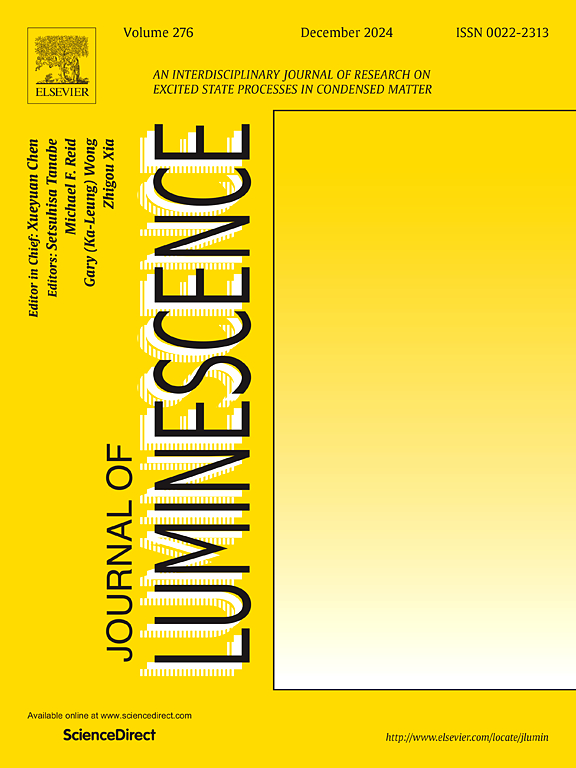未掺杂和铕掺杂CaAl2O4持续发光的内在缺陷性质
IF 3.3
3区 物理与天体物理
Q2 OPTICS
引用次数: 0
摘要
本文对还原未掺杂和铕掺杂的CaAl2O4的持续发光(AG)、光致发光(PL)和热致发光(TL)进行了比较研究,以确定Eu和氧空位在该材料持续发光过程中所起的作用。当被光子能量在3.18 ~ 5.39 eV之间的光照射时,PL强度在数百秒内逐渐增加,然后达到稳定水平。这种现象被称为光充电(PC)。AG根据贝克勒尔定律衰减,特征时间为几十秒。随后对荧光粉加热产生TL,其峰值在70℃左右,活化能约为0.65 eV。虽然eu掺杂样品的PL、AG和TL的强度明显高于未掺杂样品,但两种样品中控制PC、TL和AG的参数值非常相似。特别是两种样品的PL、AG和TL的发射光谱形状非常相似,呈现出一个单一的发射带,峰值约为2.8 eV,宽度为0.3 eV。这意味着复合或发光中心是内在缺陷,可能是氧空位。掺杂和未掺杂样品的激发光谱显示出一个约3.9 eV和一个约4.9 eV的激发区。然而,Eu掺杂样品的激发区更宽,并表现出表明Eu参与光子能量吸收的附加特征。在PL发射光谱中没有Eu发射表明激发能从Eu转移到氧空位。两种样品的AG和TL产生光谱随激发光子能量的增加而单调增长,与PL激发光谱似乎无关。这说明Eu对AG和TL强度的增强作用主要是促进氧空位的形成。本文章由计算机程序翻译,如有差异,请以英文原文为准。
On the intrinsic defect nature of persistent luminescence in undoped and Eu-doped CaAl2O4
In this paper, we present a comparative study of the persistent luminescence or afterglow (AG), photoluminescence (PL) and thermoluminescence (TL) in reduced undoped and Eu-doped CaAl2O4, in order to establish the roles played by Eu and the oxygen vacancy in the processes responsible for the persistent luminescence of this material. When illuminated by light with a photon energy between 3.18 and 5.39 eV, the PL intensity gradually increases over hundreds of seconds before reaching a steady level. This phenomenon is known as photo-charging (PC). The AG decays according to the Becquerel law with a characteristic time of tens of seconds. Subsequent heating of the phosphors results in TL, which peaks at about 70 °C and has an activation energy of about 0.65 eV. Although the intensity of PL, AG and TL are significantly higher for the Eu-doped sample than for the un-doped sample, the values of the parameters that govern the PC, TL and AG are very similar for both samples. In particularly the emission spectra of PL, AG, and TL for both samples are very similar in shape, exhibiting a single emission band that peaks at approximately 2.8 eV with a width of 0.3 eV. This implies that the recombination or luminescence centers are intrinsic defects, presumably oxygen vacancies. The PL excitation spectra for the doped and undoped samples exhibit an excitation region around 3.9 eV and one around 4.9 eV. However, the excitation regions for the Eu-doped sample are broader and exhibit additional features indicating the participation of Eu in the absorption of photon energy. The absence of the Eu emission in the PL emission spectra suggest that the excitation energy is transferred from the Eu to the oxygen vacancy. The AG and TL creation spectra for both samples grow monotonously with increasing excitation photon energy and seem unrelated to the PL excitation spectra. This suggests that the role of Eu in enhancing the AG and TL intensity is mainly to facilitate the formation oxygen vacancies.
求助全文
通过发布文献求助,成功后即可免费获取论文全文。
去求助
来源期刊

Journal of Luminescence
物理-光学
CiteScore
6.70
自引率
13.90%
发文量
850
审稿时长
3.8 months
期刊介绍:
The purpose of the Journal of Luminescence is to provide a means of communication between scientists in different disciplines who share a common interest in the electronic excited states of molecular, ionic and covalent systems, whether crystalline, amorphous, or liquid.
We invite original papers and reviews on such subjects as: exciton and polariton dynamics, dynamics of localized excited states, energy and charge transport in ordered and disordered systems, radiative and non-radiative recombination, relaxation processes, vibronic interactions in electronic excited states, photochemistry in condensed systems, excited state resonance, double resonance, spin dynamics, selective excitation spectroscopy, hole burning, coherent processes in excited states, (e.g. coherent optical transients, photon echoes, transient gratings), multiphoton processes, optical bistability, photochromism, and new techniques for the study of excited states. This list is not intended to be exhaustive. Papers in the traditional areas of optical spectroscopy (absorption, MCD, luminescence, Raman scattering) are welcome. Papers on applications (phosphors, scintillators, electro- and cathodo-luminescence, radiography, bioimaging, solar energy, energy conversion, etc.) are also welcome if they present results of scientific, rather than only technological interest. However, papers containing purely theoretical results, not related to phenomena in the excited states, as well as papers using luminescence spectroscopy to perform routine analytical chemistry or biochemistry procedures, are outside the scope of the journal. Some exceptions will be possible at the discretion of the editors.
 求助内容:
求助内容: 应助结果提醒方式:
应助结果提醒方式:


